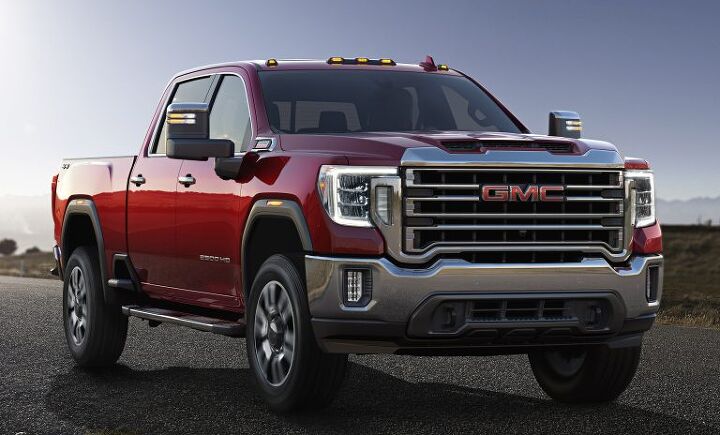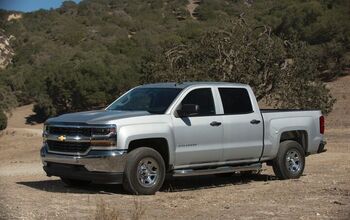General Motors Halts Pickup Truck Production Again

It’s no surprise that automotive computer chips are harder to find than potato chips at a Beachbody convention. GM has been hit hard by the shortage, forced to idle production of its most profitable machines while choosing to de-content some of their vehicles in a bid to keep the lines humming.
Truck production will take another hit this week, with a trio of pickup plants scheduled to fall silent for seven days starting on August 9th.
According to a report by the Detroit News, The General confirmed yesterday that their Heavy Duty plant in Flint, plus the light-duty outfits in Mexico and Indiana, will go offline this coming Monday. The company figures a week’s break will ease the situation and plans to have the place rocking again within a week but that timeline could change – for better or worse – depending on what is an increasingly fluid situation.
And, before you ask, this is a different shutdown than the one on which we reported earlier. Monday’s action will mark the second time GM truck production has halted thanks to a shortage of semiconductors, though the HD facility in Flint did manage to retain one shift during that hiccup. That will not be the case this time around.
Barren dealer lots should be familiar to most of our readers by this point in the calendar year 2021, and the following list of temporarily shuttered GM factories should explain why. In addition to the truck stoppage mentioned above, facilities at Spring Hill, Lansing, CAMI (Canada) Ramos (Mexico), and San Luis (Mexico) have all been down since July 19. The crew in Tennessee is not scheduled to restart until Monday, Lansing resumes on August 16th, while San Luis and CAMI shutdowns could potentially stretch into September. All those plants assemble money-making crossovers and SUVs, the type consumers typically snap up by the yaffle during normal times. Models include – among others – the XT4/XT5, Acadia, Equinox, and Terrain.
Alert readers will recall that, in a bid to keep a trickle of trucks flowing to hungry dealers, GM ceased including some chip-driven features such as start/stop and Dynamic Fuel Management. Your author recently spent a week in a GMC Sierra powered by a 5.3L V8 that was affected by these changes and can report that fuel economy did take a small hit compared to equivalent testing in an equally-optioned truck last year. Overall performance while towing a heavy trailer was unaffected, as you’d likely expect.
GM is hardly alone in this boat, with plenty of other manufacturers dealing with production challenges of their own. The global chip shortage is said to have stemmed from the pandemic’s early days, in which car production waned by demand for electronics by house-bound humans skyrocketed. Chip suppliers, then directed their flow of product in that direction, a blip that has yet to smooth out in the favor of automakers.
[Images: GMC]

Matthew buys, sells, fixes, & races cars. As a human index of auto & auction knowledge, he is fond of making money and offering loud opinions.
More by Matthew Guy
Latest Car Reviews
Read moreLatest Product Reviews
Read moreRecent Comments
- Steve Jacobs I've got a bright Red Kia EV6. Easy to find in a parking lot.
- MKizzy Gently used EV6's under $30K aren't hard to find and have the range and style to almost intrigue me into taking the EV plunge. However, I'll wait for a mid-sized non-luxury EV sedan or wagon which is not a tablet housing a car (Model 3) or sacrifices too much usable space for the sake of style (Ioniq 6) before I go electric. I'm not holding my breath.
- Arthur Dailey Am currently comparing both vehicles. Some issues not addressed in the article 1) the wait times for most RAV4's are currently considerably longer, 2) RAV4's are among the most stolen vehicles in my area (the GTA), 3) Mazda has a superior warranty. Manufacturing locations are perhaps a toss up. For the majority of these vehicles sold in the Canadian market from what I can ascertain, CX-5's are manufactured in Japan, and RAV4's in Alliston Ontario. One area where I will disagree with Matt is in the upholstery. I far prefer cloth to leather. With grandchildren and a dog, there is far more chance that the leather will be cut or scratched. And leather, particularly in black is too hot in the summer and very cold when you first sit on it during a Canadian winter. Cloth is the winner in that competition, but still an inferior choice to rich 1970's style velour upholstery.
- Eliyahu I've had my 2018 CX-5 FWD top trim for about 18 months. It is fun to drive and a nice design. Mazda really did a great job of making the most out of the platform when they did the design refresh. The driver's seat, however, is overly firm and perhaps a tad too small. I have also come to appreciate the open feeling of the Forester compared to the well-organized but more closed in cockpit of the CX-5. A minor quibble would be the smallish gas tank. Overall, a very nice design.
- Redapple2 CX5. Rented one 2 yr ago. ~2000miles. Issues. 1 Thumbwheel controller not good. 2. Sweeping curve on the interstate passing a car, the automatic braking picked up a car in the lane over. Beeps and slight braking. Not drop anchor mode, but still head scratching. But it looks so dam good. Wonderful still after many years. CX5 all the way!!!



































Comments
Join the conversation
@Matthew--I would be interested in a follow up on Ford on the chip shortage. I read on Ford Authority that the chip shortage could last thru June of 2022. I would be interested in how this will effect the production of the new Maverick which at the latest Ford scheduled to start production on August 16. I was told by the Ford dealership that it could be as late as next Spring until I get the Maverick that I ordered. I will hold onto my 2008 Ranger until I get the Maverick.
If the chip shortage persists the manufacturers might go more to the consumer placing orders for new vehicles. Ford lets you select your vehicle on their website and then you get a email notification and call by the dealer. If this becomes permanent the dealers can reduce the size of their locations with less space to park inventory and less showroom space.